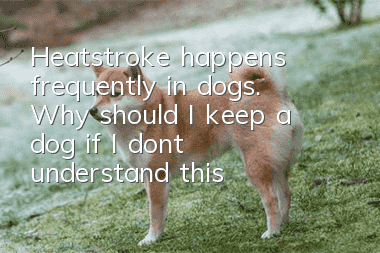Heatstroke happens frequently in dogs. Why should I keep a dog if I don’t understand this?

The hot summer season is already very difficult for humans, let alone dogs with thick coats?
Every summer, we always hear about the tragedy of dogs suffering from heatstroke because the temperature is too high.
1
The golden retriever in the picture is called Carosi. After giving it a bath, the owner did not use a hair dryer to dry it for convenience. Instead, he kept it on the balcony to bask in the sun, hoping to dry it naturally.
With a high temperature of nearly 40 degrees, the golden retriever quickly developed symptoms of heatstroke, and the owner only found out an hour later that Carosi had already passed away.
2
In a community in Xiaoshan, Hangzhou, an Alaskan was kept on the balcony at one or two o'clock at noon in the summer.
An eyewitness said: "I found the dog still alive and kicking on the balcony at first, but he died at half past one. I felt very distressed when I saw it."
The owner took the photo of the dog when he was alive and regretted it, but nothing could save his life.
3
Ms. Tian from Yangzhou drove her several-month-old pet dog to a nearby mall to buy electrical appliances. She was worried that the mall would not allow small dogs to enter, so she left the dog alone in the car.
Ms. Tian also thought that she was afraid that the puppy would be suffocated, so she rolled down the car window. As a result, in less than 40 minutes, when Ms. Tian came back, the dog had died suddenly in the car.
Every summer, similar incidents happen frequently. The weather is getting hotter and hotter. What should dog owners do to let their dogs spend the summer safely?
Why are dogs so prone to heatstroke?
Dogs have underdeveloped sweat glands and cannot regulate their body temperature through sweating like humans. They can only discharge heat through the sweat glands on their tongues and soles of their feet, which is very inefficient.
When the temperature is too high, the body's metabolism is strong, it produces more heat, dissipates less heat, and heat accumulates in the body, making dogs prone to heatstroke.
In addition, dogs cannot speak, cannot directly express when they are hot or thirsty, and cannot take care of their bodies to replenish water at any time, so dogs are many times more likely to suffer from heat stroke than humans!
Which type of dog is particularly susceptible to heatstroke?
A dog with long hair and thick coat. Such as: Samoyed, Golden Retriever, Husky
Short-nosed dogs: Because of their short nasal cavities and respiratory tracts, excessive exercise will cause difficulty in breathing. Such as: Bulldog, Pug, Chow Chow
Obese dogs: Thicker body fat will hinder heat metabolism.
Puppies: Their metabolism is higher and they tend to produce more heat.
Older dogs: Because the body’s circulatory function decreases, the heat generated is not easily discharged from the body.
Dogs with cardiopulmonary insufficiency and cardiopulmonary disease
What are the symptoms of heatstroke in dogs?
Mild heatstroke—drooling, thick saliva, excessive or heavy panting, and accelerated heart rate
If your dog has these symptoms, you need to immediately move the dog to a cool and ventilated place, remove the restraints on the dog (collar, chest strap), and add an appropriate amount of fresh water to the dog.
Moderate heatstroke—difficulty breathing, body fever, bright red gums
If these symptoms occur, you need to immediately wet the dog's body with cold water. If possible, you can give the dog a cold bath. When taking a bath, be careful to support the dog's head to prevent it from choking on the water. At the same time, you can use an electric fan to cool down. After the symptoms are relieved, they are sent to the hospital for treatment.
Severe heatstroke - foaming at the mouth, convulsions, shock and coma
In this case, you need to be sent to the hospital immediately. On the way to the hospital, wrap the dog's whole body with cold water or a wet towel. If possible, use alcohol to wipe the hairless parts of the abdomen and limbs to help the dog dissipate heat. During delivery, pay attention to lowering the dog's head and straightening its neck to maintain smooth breathing and prevent vomiting.
Don’t use ice water or ice cubes!
Ice water will constrict blood vessels and reduce the circulation speed of the skin, resulting in slower heat dissipation, which is not conducive to rescue.
Prevention is better than cure!
Avoid high temperature exposure
Place the dog in a place with good air circulation and away from the sun, and give it air conditioning if necessary.
In addition, do not arrange to walk your dog at noon. It is best to choose a time when the temperature is cooler in the early morning or evening. If you want to go out, you must bring drinking water and reduce the amount of exercise.
When the dog is doing exercise, the dog should be allowed to calm down and rest every 30 minutes to lower the body temperature. Do not continue to do strenuous exercise for a long time, such as running, playing games, etc., even if the dog does not want to stop the activity.
Make sure your dog has enough water
mustPrepare a fresh water source so that your dog can drink cool, clean water at any time to prevent dehydration and heatstroke.
Cars are invisible killers
Do not leave your dog alone in the car. Under the scorching sun, the temperature inside the closed car will rise sharply, which may kill your dog in less than 20 minutes.
Summer is the season when dogs have a high incidence of heatstroke, so dog owners must do a good job in heatstroke prevention. If a dog suffers from heatstroke if not treated in time, it is likely to die, so dog owners must pay attention~
- Ten rules for properly raising dogs
- The Importance of Checking Your Dog’s Anal Glands
- How to keep an adult shepherd dog in good obedient habits, shepherd dog training!
- How to train a young Bichon Frize? Tips on training a 2-month-old Bichon Frize!
- Popular dogs may not be suitable for you to keep! Take stock of the pros and cons of popular dog breeds
- Does a dog have a nosebleed because he is angry? In fact, it is a sign of serious illness. If the owner does not deal with it in time, it will harm the dog.
- Dog first aid methods must be learned by poop shovelers!
- How to tell if a puppy has been vaccinated?
- How to correct a dog eating poop
- Why does the dog keep spinning in circles?



